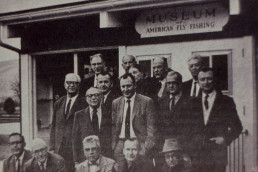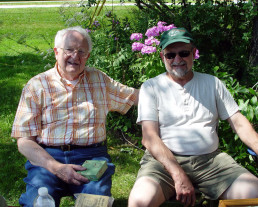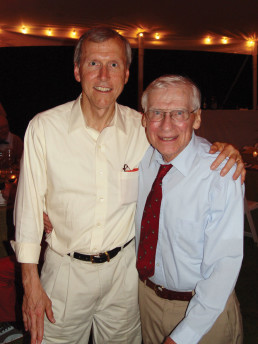Birds of a Feather: The Founding Days of the Museum By Ted Rogowski
It all started in 1968 with a bundle of bamboo fly rods—some rare—in a corner of the Orvis shop. Leigh Perkins was trading a new rod at twenty percent discount for your old bamboo rod, and Hermann Kessler, husband of Helen Shaw (a fly-tying legend in her own right), saw a Leonard rarity among the turn-ins. Having also recently come across the magnificent fly panel display created by Mary Orvis Marbury, Kessler noted, “These belong in a museum!” Thus, the germ of the American Museum of Fly Fishing was born.
The creative genius of Leigh Perkins was not to be denied. Leigh offered Kessler Vermont bait that would attract him, Ed Zern, Arnold Gingrich, Gene Anderegg, and me more strongly than Vermont cheddar: an invitation to hunt partridge over two champion Perkins spaniels. This was an organizing crew who couldn’t resist bird hunting Vermont woods after drafting and legal sessions on several October Saturday mornings: a fly-fishing museum we shall have! Room and board for the five guests was conveniently arranged at the Perkins residence with sheets thrown over couches, sleeping bags borrowed from the teenaged boys, twelve scrambled eggs (medium, please!), and half a loaf of bread at each breakfast sitting. Gingrich dried dishes as well as he punctuated the grammar of Esquire magazine.
At the hunt, the pair of retrievers carried an awful trait: regardless of who downed the flushed bird, the bird was retrieved and returned directly to Leigh. (They knew who was in charge of roast partridge for dinner.) So, the very first museum was a rack of fine bamboo fly rods set along the far wall of the Orvis shop. The weekend ventures orchestrated by Leigh yielded the museum charter, the IRS 501(c)3 paperwork, and four Vermont partridge for the dinner table.
Upon graduation from Columbia Law School in 1956, Ted Rogowski practiced in New York City with Cadwalader, Wickersham and Taft. Fishing and hunting experiences were gained with the Mid-town Club each Wednesday at Manny Wolf’s Chop House. His career law practice was with the Environmental Protection Agency, first in Washington, D.C. (1966–1972), then in Seattle (1972–1992).

The original board of trustees in 1970. First row, from left: Dick Finlay, D. Clarke Corkran, Alvin Grove, Ted Rogowski, and Wes Jordan. Second row, from left: Milford K. Smith, Hermann Kessler, Clayton Shappy, Leigh Perkins, Donald DuBois, and Capt. Raymond Kotrla. Third row, from left: Austin Hogan, Ben Schley, Jane Gingrich, Arnold Gingrich, and Harry Darbee. Not pictured: Warren Shepard and Gene Anderegg.
It’s the People Who CountBy James Hardman

Trustee Emeritus James Hardman (left) and Bob Selb in 2014.
For the past twenty-five years at the American Museum of Fly Fishing, I have been a volunteer—a helper, a facilitator, a photographer, and at times a builder—but most of all, I’ve been an observer.
Most of my time was spent cataloging our reels. We have evolved through at least three database programs, each with upgrades and advantages. Tours of our exhibits now online will ultimately lead to online access to our archives. We are setting new standards of professionalism.
And it’s the people who count. It helps that we share the common passion and interest of the sport and history of fly fishing, but over the years, the people who made our museum “go”—our trustees, our directors, our staff, and our volunteers—have pulled together to maximize our individual strengths.
Abraham Lincoln practiced a management style that remains relevant today and has been embraced by several of our directors: get out of the office, get to know the people, plant the vision, listen to the people, and pull them together to make things happen. This was described as “management by wandering around” by Thomas J. Peters and Robert H. Waterman Jr. in their 1982 book, In Search of Excellence.
If there is one quality that truly sets our museum apart from so many others, it is our presentation. Our exhibits and our journal are striking and well respected. The content, artistic impact, and “telling the story” have been impressive.
If we are to celebrate anything in our fifty-year history, it is our success in marrying vision with effective management. As a friend from Jersey City put it, “We done good.” Our museum people have done good. Three cheers for our people: for their vision, wisdom, financial support, effort, creativity, and accomplishments!
And a hearty huzzah to everyone who has made it happen these past fifty years—and to those who make it happen today.
Trustee Emeritus James Hardman is a machinist and has studied, collected, and restored early reels for more than forty years. His most recent contribution to the journal was the two-part “Synthetics in Fishing Tackle—What’s in the Mix: Natural Rubber, Gutta-Percha, and Modified ‘Stuff,’” which appeared in Winter and Spring 2012 (vol. 38, nos. 1 and 2).
Fifty YearsBy Richard Tisch
A small museum achieving a half-century life span is notable. I have been a trustee of the American Museum of Fly Fishing for about a quarter century. My tenure is neither an achievement nor notable, but it is a happy circumstance for me. A few other trustees share this longevity, with one far exceeding it and some almost reaching it. Such loyalty by many, however, is notable. Why do these trustees—and almost three dozen other women and men—devote their time and energy and annually donate hundreds of thousands of dollars to this modest nonprofit in rural Vermont?
Why do many others, former trustees, other members of AMFF, and unaffiliated people give to this charity?
Why are there staff members of this wonderful museum with tenures matching mine?
Why does AMFF even exist? (Some of my nonfishing friends have asked me this question.)
AMFF is one of about 35,000 museums in the United States (that number is greater by far than the total of Starbucks and McDonald’s in America—this is a good thing). It is one of more than 1,500,000 nonprofits in the United States. But it is also the only museum in the world with such a remarkable number and variety of fly-fishing artifacts: rods, reels, flies, books, artwork, etc. And people still donate to it. In the past six months, the museum has received a collection of more than two hundred angling books; several limited-edition books; a Seamaster saltwater fly reel; fifteen new flies developed and tied by a renowned western fly fisher; and a three-piece, 10-foot Calcutta cane rod. This is just a sampling of recent donations, which, I expect, will continue.
So what are the answers to these questions?
Here are mine: I love fly fishing and have for more than fifty years. I love the pristine streams and rivers, the flats and oceans in which game fish swim. I love the challenge of casting flies to them, often without success. I love the deliberate rise of a trout, the slashing strike of a northern pike (yes, a pike), the soaring leaps of tarpon, and unforgettable pulls of Atlantic salmon. And I love the surroundings in which all these fish live. As well, I believe E. T. Brown got it right: “When they go fishing, it is not really fish they are after. It is a philosophic meditation.”*
Finally, I suspect many other devotees of the museum share these feelings and want to ensure, as I do, that the joys of fly fishing and its rich tradition are available to others.
Richard Tisch is a trustee and past president of the American Museum of Fly Fishing.
*E.T. Brown, Not Without Prejudice: Essays on Assorted Subjects (Melbourne: Cheshire, 1955), 142. Cited in Jeffrey S. Cramer, ed., “Appendix: Misquotation and Misattributions,” The Quotable Thoreau (Princeton, N.J.: Princeton University Press, 2011), 466, the misattribution being “Many men fish all their lives without ever realizing that it is not the fish they are after.”

Trustee Richard Tish and the late Stan Bogdan at the museum’s grand reopening celebration on 11 June 2005. Photo by Jim Hardman.

